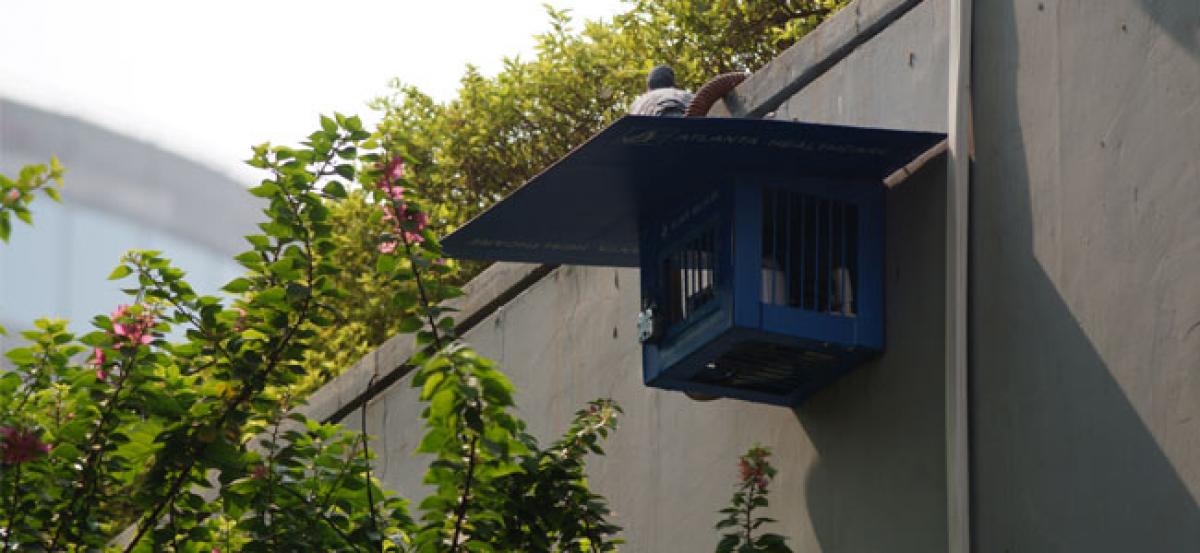Live
- Over 7,600 Syrians return from Turkiye in five days after Assad's downfall: minister
- Delhi BJP leaders stay overnight in 1,194 slum clusters
- Keerthy Suresh and Anthony Thattil Tie the Knot in a Christian Ceremony
- AAP, BJP making false promises to slum dwellers for votes: Delhi Congress
- 'Vere Level Office' Review: A Refreshing Take on Corporate Life with Humor and Heart
- Libya's oil company declares force majeure at key refinery following clashes
- Illegal Rohingyas: BJP seeks Assembly session to implement NRC in Delhi
- Philippines orders full evacuation amid possible volcanic re-eruption
- Government Prioritizes Welfare of the Poor, says Dola Sri Bala Veeranjaneyaswamy
- Two Russian oil tankers with 29 on board damaged due to bad weather
Just In

The government’s efforts to control air pollution got a shot in the arm with the installation of four Air Quality Monitors across four locations of Gurugram. Under the initiative of DLF Foundation, four Air Quality Monitors have been installed in DLF Phase 1-5.
Gurugram: The government’s efforts to control air pollution got a shot in the arm with the installation of four Air Quality Monitors across four locations of Gurugram. Under the initiative of DLF Foundation, four Air Quality Monitors have been installed in DLF Phase 1-5. Equipped with highly advanced technology, these smart devices can measure PM 2.5 along with temperature, humidity on 24*7 bases and transmit real-time data through the cloud. The move will help get deeper insights into patterns of air pollution across different locations in Gurugram, identify trends that lead to higher pollution in certain areas and also understand localized impact and cause of pollution.
DLF Air Quality Index would be released at periodically. In the next phase, DLF Foundation plans to extend the air quality monitoring to more zones in Gurugram towards making DLF Air Quality index an effective tool in combating pollution at a citywide and localized level.
“The move is our first yet vital towards ensuring better air quality to the citizens of Gurugram. Air pollution is a major health hazard especially in Delhi-NCR and this step encourage efforts to improve the air quality in Gurugram,” said Col. Prakash Tewari, Executive Director, DLF Foundation.
Findings
· 1) According to the data from Air Quality Monitor, sustained level of ground pollution in Gurugram even during monsoon / rain period. Even on days when the air quality is satisfactory it towards the higher end of the range [51-100]. Caution one needs to take while looking at this data is the fact that this is hourly average, which means that one is breathing this level of pollution through the day and the exposure is NOT limited to few hours in a day.
2) Across the Air Quality monitors, one observed that the trend of movement of pollution across the zones is similar. i.e. when the pollution levels go up, they go up across each of the areas and similarly when it comes down it comes down across all monitors. However, at a point in time there is upto 30-35% variance in the readings across the zones.
·3) If one looks at the hourly data from each of the monitors, one does see certain local peaks being formed in specific areas due to some local pollution factor and also trends in terms of time of the day when the pollution levels are high. DLF is now studying these trends to link it to reasons that possibly is leading to these peaks at specific time of the day and then working on a solution to tackle the same
·4) While it is early days but DLF has taken the right step in addressing the concern around pollution. DLF has already started working on 2 critical aspects of root causes – vehicular pollution and diesel gensets. As next phase to this initiative, DLF now plans to extend the air quality monitoring to more zones in Gurugram towards making DLF Air Quality index an effective tool in combating pollution at a City wide and localised level.
Taking into account that diesel exhaust, which is carcinogenic, is a major contributor to PM10 and PM2.5 emissions, DLF Foundation is working with technical institutes like IIT to implement practical solutions to mitigate this effect. It along with stakeholders has also initiated a multi-pronged approach towards attacking each of these problems in a systematic way focusing on short-term and long-term projects.
Air pollution has assumed concerns worldwide and has been linked to incidence of respiratory diseases like asthma, bronchitis and lung cancer. As per the WHO’s latest report of 2016, 13 of the top 20 most polluted cities in the world are from India. A recent report mentioned that the National Capital Region residents are losing out on almost 6 years of life because of the dangerous air pollution levels. If WHO standards were met in NCR, people would live nine years longer.
Despite the Supreme Court’s ban on crackers, this Diwali, air quality in Gurugram deteriorated over five times during the Diwali night. According to Haryana State Pollution Control Board, the Air Quality Index (AQI) value for 24 hours Thursday-Friday in Gurgaon was 365 micrograms per cubic metre (ug/m3), which falls into the category of ‘very poor.’

© 2024 Hyderabad Media House Limited/The Hans India. All rights reserved. Powered by hocalwire.com







